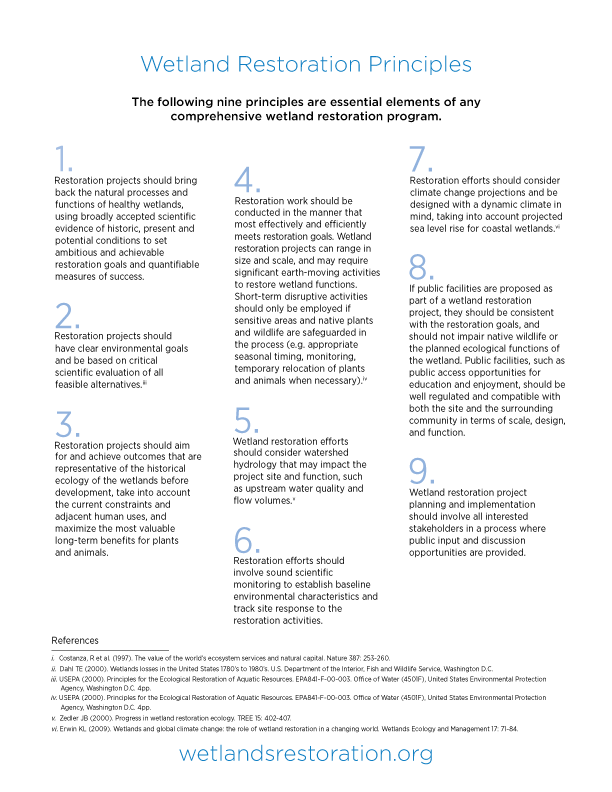The following nine principles are essential elements of any comprehensive wetland restoration program.
Principle 1 (Functional Integrity): Restoration projects should bring back the natural processes and functions of healthy wetlands, using broadly accepted scientific evidence of historic, present, and potential conditions to set ambitious and achievable restoration goals and quantifiable measures of success.
Principle 2 (Scientific Basis): Restoration projects should have clear environmental goals and be based on critical scientific evaluation of all feasible alternatives. (i)
Principle 3 (Ecological Balance): Restoration projects should aim for and achieve outcomes that are representative of the historical ecology of the wetlands before development, take into account the current constraints and adjacent human uses, and maximize the most valuable long-term benefits for plants and animals.
Principle 4 (Appropriate Scale): Restoration work should be conducted in the manner that most effectively and efficiently meets restoration goals. Wetland restoration projects can range in size and scale, and may require significant earth-moving activities to restore wetland functions. Short-term disruptive activities should only be employed if sensitive areas and native plants and wildlife are safeguarded in the process (e.g., appropriate seasonal timing, monitoring, temporary relocation of plants and animals when necessary). (ii)
Principle 5 (Watershed Hydrology): Wetland restoration efforts should consider watershed hydrology that may impact the project site and function, such as upstream water quality and flow volumes. (iii)
Principle 6 (Scientific Monitoring): Restoration efforts should involve sound scientific monitoring to establish baseline environmental characteristics and track site response to the restoration activities.
Principle 7 (Climate Change): Restoration efforts should consider climate change projections and be designed with a dynamic climate in mind, taking into account projected sea level rise for coastal wetlands. (iv)
Principle 8 (Compatible Uses): If public facilities are proposed as part of a wetland restoration project, they should be consistent with the restoration goals, and should not impair native wildlife or the planned ecological functions of the wetland. Public facilities, such as public access opportunities for education and enjoyment, should be well regulated and compatible with both the site and the surrounding community in terms of scale, design, and function.
Principle 9 (Stakeholder Inclusion): Wetland restoration project planning and implementation should involve all interested stakeholders in a process where public input and discussion opportunities are provided.
References:
i. USEPA (2000). Principles for the Ecological Restoration of Aquatic Resources. EPA841-F-00-003. Office of Water (4501F), United States Environmental Protection Agency, Washington D.C. 4pp.
ii. USEPA (2000). Principles for the Ecological Restoration of Aquatic Resources. EPA841-F-00-003. Office of Water (4501F), United States Environmental Protection Agency, Washington D.C. 4pp.
iii. Zedler JB (2000). Progress in wetland restoration ecology. TREE 15: 402-407.
iv. Erwin KL (2009). Wetlands and global climate change: the role of wetland restoration in a changing world. Wetlands Ecology and Management 17: 71-84.


